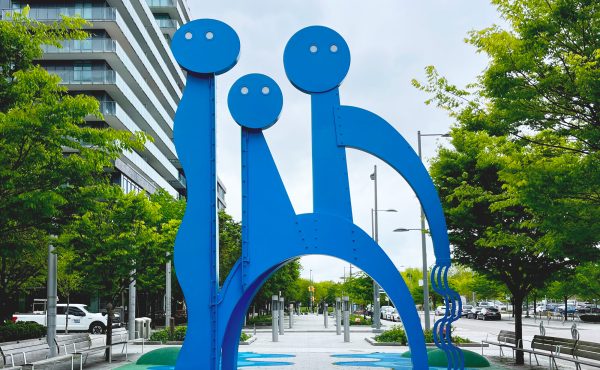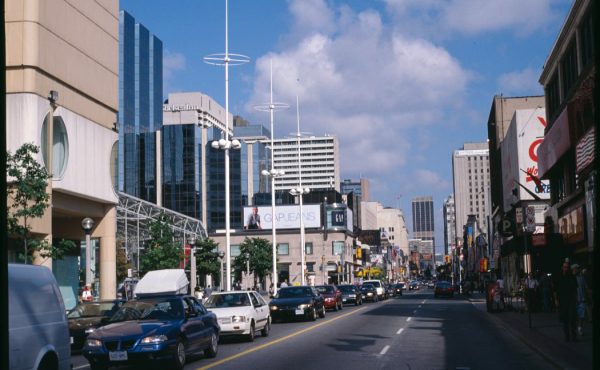
O’Keefe Lane and St. Enochs Square are areas of the city thousands of people walk by without noticing every day. Why? Because the lane showcases the dirty, grungy rears of otherwise fancy buildings like the Ed Mirvish Theatre (formerly the Pantages). Used by smokers on break and numerous delivery loads and garbage trucks, the alley beckons only the most adventurous of pedestrians — those willing to trust their luck in the alley.
One group of people recently came together, though, for a workshop aimed at finding a solution to the problem: a way to make O’Keefe Lane and St. Enochs Square not only safe, but also beautiful.
So began a project, spearheaded by 8-80 Cities, to investigate revitalizing these spaces. With the help of the renowned, Copenhagen-based Gehl Architects, and partners such as ING Direct, the project is off to a good start. Recent interest has been shown by many community members, as well as former Toronto chief planner Paul Bedford and Ward 27 Councillor Kristyn Wong-Tam.
“If we’re not building streets or public spaces that are beautiful and safe that are welcoming and inducing of pleasure, then we know that people are not going to come back, and what we want are people in our spaces,” says Wong-Tam, a passionate advocate for safe public areas.
Bedford, who has been active in the conversation about the space, agrees. He initiated similar projects during his time as the City’s chief planner, and being someone who is passionate about the city, he’s an advocate for public spaces that will invite people in and entice them to stay. Bedford says looking at pathways underneath Toronto’s downtown core and comparing them with laneways aboveground would provide many exciting places to look to develop. “You look at the potential, there’s a whole new layer of city that can be added, developed, utilized — commercial opportunities, restaurants, coffee, entertainment, whatever — and extend the pedestrian public realm through another whole layer of the downtown.”
There remain challenges, though, one of which being a lack of light. The lane is lined by buildings that are tall enough to disallow any light from Yonge Street sneaking in. The only light filtering through at night is what spills in from the end that faces Yonge-Dundas Square. Suggestions have been thrown around to put in strings of lights on the buildings so that it appears safer at night.
Ewa Westermark, an associate at Gehl Architects, says her hope for the space is that it becomes a destination, rather than just a pathway to somewhere else. The introduction of benches, pop-up cafés, and greenery may entice people to wander down and spend some time in the laneway. And with a world-class music venue, three theatres, a cinema, and Yonge-Dundas Square all nearby, it’s been suggested to turn O’Keefe Lane into a theatre –entertainment inspired walkway. Imagine skits in the laneway before a show at the Ed Mirvish Theatre, or impromptu recitals before a show at Massey Hall. The opportunity is ripe to attract people to what’s now an unattractive space, and provide an identity for area that’s lacked one since the brewmaster closed up shop.

At one point, the O’Keefe Lane was located right beside the O’Keefe Brewery, which operated under several different names from around 1840 until it was demolished in the 1980s. Eugene O’Keefe was an Irish businessman and banker who moved to Canada when he was five years old. The brewery, located at the corner of Victoria and Gould streets (where the AMC cinema and Ryerson Bookstore is located), was known as Victoria Brewery when O’Keefe acquired it in 1861. The brewery’s name was changed in 1891, and the adjacent laneway was also renamed from Victoria to O’Keefe Lane.
Although the lane pretty much retained its historic purpose as a route for deliveries and pick-ups, downtown Toronto has evolved; it is now a tourist destination, a shopping zone, and a supposedly pedestrian-friendly location. But with streets catering more to automobiles than foot traffic (pedestrian scrambles aside), Wong-Tam, Bedford, Westermark, and other urbanists are encouraged by the potential O’Keefe Lane presents.
Wong-Tam is especially excited about this project. Downtown, she says, is an area that needs to accommodate the amount of foot-traffic it gets, so that it attracts more. “I think that there is a time and that time is now that we start to rethink and re-imagine how we can use the city streets to foster some of our common city objectives.”




11 comments
Since when does a city have to shove pedestrian-friendly spaces in every corner and alley to be a pedestrian-friendly city? I am all for improving public space to increase the pedestrian experience, but turning lanes into places to sit and hang out just seems off. Lanes already have a function – to serve the buildings they are behind. This is through providing space for delivery trucks, garbage pickups, backstage entrances, etc. The whole reason these lanes exist is to get these functions away from people on the streets to make it safer for pedestrians. People shouldn’t be back there in the first place.
I think our resources would be better spent on improving the public spaces in front of buildings, along the streets, in parks – places where people should actually be.
Why try to recreate the wheel? T.O. is so 3rd class….
Check out what a sleepy college town in Colorado was able to do…
http://www.downtownfortcollins.org/alleys.html
Ah, the oldest Toronto chorus around, the NO’s, are still going.
Love the ideas. The lane way is unique in its proximity to Yonge and local landmarks like Dundas Sq and Massey Hall. It deserves to be fixed up and have its usage expanded from just pick up and deliveries.
Despite the above naysayers — ironically either complaining about the project or how the project sucks — revitalizing minimally used spaces in the core of the city is a great step.
Shawn: Actually, your response is more of the typical Torontonian – point out someone who has a different opinion than your own, then walk away without any constructive feedback. I would expect that from a random commenter, but not from a Spacing contributor such as yourself.
I would love to know why my comment labels me as a naysayer. Laneways are laneways and they serve specific functions. You want to build a pretty public space with benches and artwork in a lane? Okay, fine. Now, where will the trucks go? Where will the garbage bins go? What about the access to firetrucks in case of a fire? Or just safety regulations in general? Were these questions considered at the workshop? I’m not a naysayer. These are just basic things that have to be considered when doing a project like this.
Romanticizing the laneway to see it as an art project won’t take it very far. I would rather we use these type of resources to focus on the areas for pedestrians that would actually matter. Let’s let laneways be laneways – they already serve their purpose just fine.
People are doing something creative/constructive. Let it happen. There are laneways like this in cities all over the world, converted to public space/commercial use. People complain about DSq not being interesting — here’s something to help that. Nooks and crannies add layers of interest to city. None happen by accident. People make it happen. Doing this doesn’t negate beautifying other spaces. Many reasons why that doesn’t happen.
So much “no” in Toronto. Let it happen.
the laneway project sounds cool but I sort of agree with TD.
So many of Toronto’s main streets which already have tons of pedestrians on them are hideous, with electrical transformers and wires overhead, and a lack of trees. they look third world.
Agree to a point Grieves – but stop everything till that’s fixed? Very separate things. Stopping one will not start another.
Shawn, I hear you. It is frustrating though that the city leaders do not seem overly concerned with the state of existing publis spaces.
All to say this lane way thing could be interesting. Toronto can have a sterile feel as the streets are so wide and the architecture dull, this has the potential to make downtown more interesting and spur more similar projects
IMHO they’re the same fight, you make this a super-space, easier to exert pressure for improvement elsewhere. Pressure comes from you and I, of course….
I think a quick and easy way to revitalize the alleyway and quickly make it a “destination” would be to do something like Market 707 on Dundas (@ Bathurst), but on a larger scale. Just line one wall with food stalls located within re-purposed shipping containers, provide a simple electrical hookup and voila, destination! Imagine a whole alleyway teaming with different smells from the massive diversity of cultures Toronto has to offer. Amazing.
Anyways…my $0.02